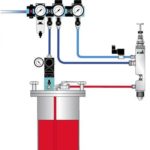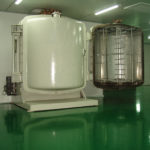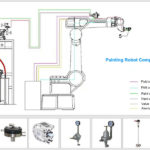The use of industrial robots in manufacturing industry is increasing, especially in harsh conditions or with high work intensity and sustainability requirements. Plus the low rate failure, makes robots widely recognized.
However, even the design of industrial robot is standardized, integration is quite high and the failure rate is low, routine inspections and preventive maintenance must still be carried out regularly. Common robots like: tandem articulated robots, Cartesian coordinate robots, Delta parallel robots, scara robots, automatic guided trolleys, etc., the maintenance in this article is mainly for articulated robots.
Maintenance of industrial robot body
General maintenance
1) Clean the manipulator
Regularly clean the base and arm of the manipulator; High-pressure cleaning equipment can be used, but direct injection into the robot should be avoided; If the manipulator is protected by grease film, remove only if required.(Strong solvents such as acetone should be avoided, plastic protection should be avoided, and non-conductive surfaces such as spraying equipment, hoses, etc., must be wiped with a wet or damp cloth to prevent static electricity.)Do not use a dry cloth.)
2) Cleaning and maintenance of hollow wrists
According to the actual situation, the hollow wrist needs to be cleaned frequently to avoid the accumulation of dust and particles, clean with pompoms, clean cloth. After the wrist is cleaned, a small amount of petroleum jelly or similar substances can be added to the wrist surface, it will be more convenient to clean in the future.
3) Regular check-ups
Check for liquid leaks; Check whether the gear clearance is too big; Check if any cable damage between the control cabinet, purge unit, the process cabinet and the robot.
4) Inspection of fixing bolts
The fastening bolts and fixing clips that fix the manipulator to the foundation must be kept clean and not come into contact with corrosive liquids such as water, acid and alkali solutions. If the protective layer such as galvanization or paint is damaged, the parts should be cleaned and coated with anti-corrosion paint.
Axle brake test
During operation, each shaft motor brake will be worn normally. In order to determine if the brakes are working properly, a test must be carried out at this point.
Test Method: Check the brakes of each axle motor as described below.
- Run the manipulator shaft to the corresponding position, total weight of the manipulator and all loads at this position reach the maximum value (maximum static load);
- The motor is powered off;
- Check whether all shafts are maintained in place;
If the manipulator still does not change its position when the motor is powered off, then braking torque is sufficient. It can be also moved manually to check if further protective measures are needed. When a robot comes to an emergency stop, the brakes help to stop, so wear and tear may occur. Therefore, repeated tests are required during the service life to verify robot maintains its original capacity.
System lubrication
1) Lubrication of shaft auxiliary gears
Make sure the robot and related systems are turned off and locked, squeeze a little (1g) of grease into each nozzle, and lubricate the grease nozzles of the secondary gear and each gear one by one, do not inject too much and avoid damaging the seal.
2) Hollow wrist lubrication
Hollow wrist includes 10 lubrication points, only a few drops of lubricant (1g) per grease nozzle, do not inject too much lubricant and avoid damage to the wrist seal and internal sleeve.
Check the oil level in each gearbox
The position of the oil filling hole in each axis is different, which requires targeted inspection, and some need to be rotated and in a vertical state before opening the cover for inspection.
Maintenance interval (the time interval can be adjusted appropriately according to environmental conditions, robot operating hours and temperature)
- Normal maintenance frequency: 1 time/day;
- Axle brake test: 1 time/day;
- Lubrication of 3-axis auxiliary gears and gears: 1 time/1000H;
- Lubrication of hollow wrist: 1 time/500H;
- Lubricating in each gearbox: the first time to replace 1 year, then every 5 years.
Maintenance of system control cabinet
Maintenance content
1) Check the heat dissipation of the controller
It is strictly forbidden to cover the controller with plastic or other materials; Leave enough space behind and on the sides of the controller (> 120mm); It is strictly forbidden to position the controller close to the heat source or put sundries on the top of the controller; Avoid the controller being too dirty; Avoid any cooling fan not working; Avoid clogging of fan inlets or outlets; Avoid dirty air filters; When no work is being performed within the controller, its front door must remain closed.
2) Clean the teach pad
The teach pad should be cleaned at an appropriate frequency based on actual needs; Although the panel paint film can withstand the corrosion of most solvents, it should still avoid contact with strong solvents such as acetone; When not in use, the teach pad should be removed and placed in a clean place.
3) Clean inside of controller
The inside of controller should be cleaned at appropriate intervals according to environmental conditions, such as once a year; Special attention should be paid to the cleaning of the cooling fan and the air inlet/outlet. Use a dust brush when cleaning and use a vacuum cleaner to suck up the dust from the brush. Do not use a vacuum cleaner to clean each part directly, otherwise it will cause electrostatic discharge, which will damage the parts; Be sure to cut off the inside of the controller before cleaning it!
4) Wash or replace the filter cloth
To clean the filter cloth, wash the filter cloth 3-4 times in 30-40 water with detergent. Do not wring out the filter cloth but can be placed on a flat surface to dry. The filter cloth can also be blown clean with clean compressed air.
5) Replace the battery regularly
The measuring system battery is a disposable battery (non-rechargeable battery); When the battery is replaced, a message appears in the message log. The battery lasts for about 1,800 hours after this information appears.(It is recommended to replace the battery when the above information appears) The battery only works in the case of a “power off” of the control cabinet. The battery life is about 7000 hours.
If the control cabinet controls the CBS unit in addition to the robot, or in the case of an 8-axis robot, the battery life is half that described above (with 2 SMU units).
6) Check the cooler
The cooling circuit is designed as a maintenance-free closed system, and all components of the external air circuit need to be regularly inspected and cleaned as required; When the ambient humidity is high, check whether the drain is drained regularly.




